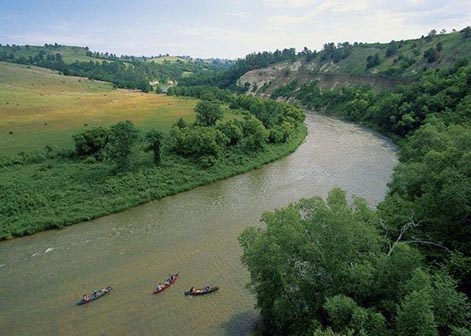Recreation Impacts on Avian Assemblages in the Niobrara River Corridor, Fort Niobrara National Wildlife Refuge
 Investigator:
Investigator:
Christopher Anderson, M.S. Student
Project Supervisor:
Dr. C. Dustin Becker, Department of Horticulture, Forestry and Recreation Resources
Dr. Philip S. Gipson, Unit Leader
Funding:
U.S. Fish and Wildlife Service
Location:
Niobrara River, Nebraska
Completion:
2003
Status:
Completed
Objectives:
Determine which bird species increase, decrease or remain constant in abundance with reard to human activities (tubing, boating, canoeing) in each habitat along the river.
Determine avian and other wildife divesity and abundance in human utilized and non-utilized areas while controlling for habitat type.
Compare flush rates and flush distances of riparian bird species during low and peak recreation use within a framework of avian life history (breeding, nesting, fledging).
Determine direct effects of human disturbance on key bird species by monitoring nesting and fledging success.
Assess indirect effects on avian communities by monitoring abundance of key avian predators (Blue Jays) and Parasites (cowbirds) along a gradient of human disturbance.
Results:
In the Sandhills of Nebraska, Fort Niobrara National Wildlife Refuge (FNNWR) is unique in having a federally designated Wild and Scenic River. Since 1961, recreation on the Niobrara River in the refuge has increased from several hundred to 30,000 people per year in 1997. Managers of the refuge are required to evaluate whether recreational activity affects wildlife.
Recreational impacts on wildlife are typically studied at the behavioral level, excluding community or population ramifications. During 2000-2002 I attempted to determine whether river recreation at FNNWR negatively affects local avifaunal community and population dynamics as well as examine immediate behavioral responses. During the 2000 breeding season, bird communities in riparian forests exposed to river recreation were compared to communities in riverside forests lacking recreation to determine if recreational presence alters community composition and spatial distribution. Presence and absence of birds were sampled via point counts. As described in Chapter 1, no apparent shift in species composition or spatial distribution was observed at the community level, refuting a predictive model.
Chapter 2 focuses on population effects of recreational activities, especially their potential to negatively impact breeding songbirds at FNNWR. Common Yellowthroat (Geothlypis trichas) was used as a model songbird due to it ubiquity and proximity to river recreation. Nests in recreated and non-recreated areas were monitored throughout the 2001-2002 breeding seasons. When nests could not be followed, a reproductive index was utilized. Neither method showed significant differences in breeding success in responses to river recreation. However, terrestrial predator communities exhibited major impacts on Common Yellowthroat productivity. Scent station studies indicated that predator activity increased during the breeding season. While river recreation had no major impact on community and population dynamics of birds in riparian forests, predation was unusually high in a common nesting species. Chapter 3 investigates behavioral responses in waterbirds to river recreation. A significant greater rate of flushing was observed in responses to recreational noise than in the absence of such disturbance. In conclusion, river recreation may provoke immediate behavioral responses in birds but had little effect on population and community level factors.
Products:
Thesis or Dissertation:
Anderson, C. D. 2003. Recreational pressure at Fort Niobrara National Wildlife Refuge: Potential impacts on avian use and seasonal productivity along the Niobrara River. Master's Thesis. (Advisor: Becker).
Professional Presentations:
Anderson, C.D., C. D. Becker, and P. S. Gipson. 2003. Life history traits of common yellowthroats in a riparian corridor illustrate a regional sink population. Cooper Ornithological Society Annual Meeting, Flagstaff, AZ.
Anderson, C. D., C. D. Becker, P.S. Gipson, B. K. Sandercock, and D. A. Rintoul. 2003. American Ornithological Union Annual Meeting. Breeding success common yellowthroat (Geothlypis trichas) within a river corridor under recreation pressure. Platform presentation.